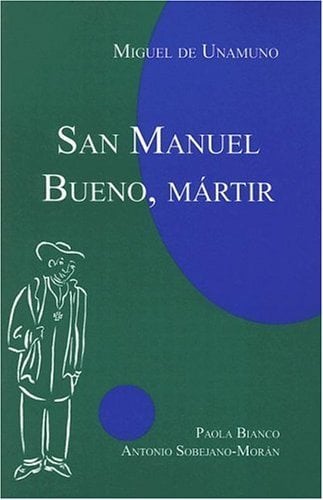
- San Manuel Bueno, Martyr
- Published by: Varios
- Level: Intermediate
- First Published in: 1939
In this famous short novel, a woman from a small Spanish village remembers the words and deeds of the local priest Manuel Bueno. Although a beacon of hope for his community, he had always guarded a secret: he did not believe in the Catholic Church doctrine of eternal life.
San Manuel Bueno, Mártir is a novel by Miguel de Unamuno published in 1931. It deals with a woman, named Ángela Carballino, and her memories of Mr. Manuel Bueno, the priest of Valverde de Lucerna, a small village located in Zaragoza, Spain. The story is narrated retrospectively, as Mr. Manuel has already died and the Church is considering his canonization. Ángela recalls how the man, a saint on Earth, changed the lives of both laymen and religious people with his simple way of seeing things and with his innate charity. However, Ángela and her brother Lázaro – among the few who really got to know him – are aware of his secret: Mr. Manuel did not really believe in eternal life, but he thought it was more important to give faith to people so they could continue living “the dream of life.” Internally, he bore the “cross of Christ,” a pain caused by his insecurity and doubts about traditional Christian beliefs. Nevertheless, at the end of his days, he dies like a hero, admired by everyone.
This short novel – which consists of barely 40 pages – deals very well with a controversial topic in Spain at the time. Does God really exist? And what about the promised “eternal life”? The irony of Unamuno’s story is that a priest, the last person you would suspect of lacking faith, is the one who does not believe. From the outside, Mr. Manuel is a real saint, a role model who transforms people’s lives and actions. When he dies, nothing is the same without him. Everyone feels that something – or someone – is missing.
"The novel deals with a woman, named Ángela Carballino, and her memories of Mr. Manuel Bueno, the priest of a small village located in Zaragoza, Spain."
The story is full of religious symbolism, starting with the names of the main characters. Ángela, the protagonist, conveys the message of Mr. Manuel’s life through her memories. “Ángela” is the feminine version of “ángel,” or “angel” in English, and in either language the word is derived from the Greek “angelos” or “messenger.” Mr. Manuel takes his name from Emmanuel, the Messiah’s name, and he is indeed a Christ-like figure within his village. His surname, “Bueno,” means “good.” Lázaro, Ángela’s secular brother, returned from America with a different vision of religion. According to him, religion is not out of fashion. He has made a big fortune in the American continent, and he comes back to Spain hoping to make his mother and sister realize that the villagers are ignorant, religious, and superstitious. He is surprised to find that the faith of his relatives does not decrease, and that Mr. Manuel is truly a special person, a saint. Lázaro is named like the man who comes back to life in the Bible, Lazarus, and like his Biblical namesake, Lázaro finds a “new life” when he abandons atheism and starts believing after meeting Mr. Manuel. As he says, “This priest is different from the others.”

Mr. Manuel is a distant figure, like an actual saint. What we know about him we receive from Ángela’s writings, and we only see him from her perspective. Very few physical features describe Mr. Manuel in the novel, asides from the fact that he is tall and has blue eyes. Unamuno intends to focus on his spiritual qualities, not his physical traits. Mr. Manuel's thoughts are also a mystery. We can only guess them based on his limited dialogues and through Ángela’s assumptions. Ángela herself is a figure who embodies the quality of intuition. She does not need Mr. Manuel to tell her what he feels. She guesses it and can feel his suffering. She also shows her loyalty to him, as she will never reveal his secret. As she suspects, Mr. Manuel does not like to be alone, because when he is alone he is tortured by his thoughts. Ángela never met her father, because he died when she was a little girl, and in Mr. Manuel she sees a spiritual father. We can speculate, maybe, that there is some romantic interest. When the priest asks Ángela why she does not marry, she answers: “You know already why I do not marry, Mr. Manuel.”
"Mr. Manuel is a distant figure, like an actual saint. What we know about him we receive from Ángela’s writings, and we only see him from her perspective."
The novel also references Calderón de la Barca’s classic play La vida es sueño (Life is a Dream), as Mr. Manuel thinks that this life is nothing but an illusion, a “cross we have to bear.” The difference is that he does not believe that there is a reward after we die. The book is not composed of chapters but fragments separated in time. The use of language is formal, but includes some archaic words from the beginning of the 20th century that are not used in current literature. For example, “decíase” (it was said) instead of “se decía” and “creeríase” (it would be believed) instead of “se creería.” Even though the narration is formal, there are still some informal bits, like: “Ahora que el párroco anda, lo que se dice, promoviendo el proceso de beatificación” (Now that the priest is going around promoting, as it's said, the beatification process). These kinds of expressions make Ángela’s discourse come across as more real and colloquial.

